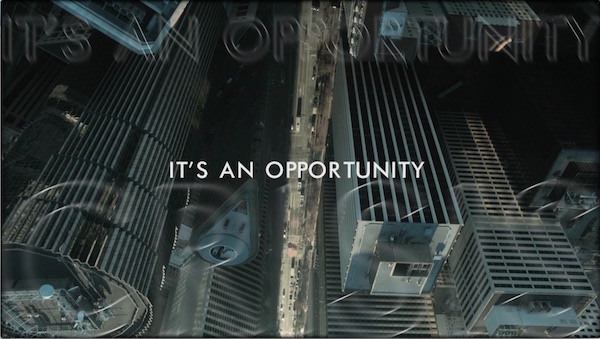America Is Hard to See: A Guide to not being depressed about US electoral politics this November
In order to make sense of state politics in the birthplace of statistical marketing and the internet, one has to be wary of the effects of these technologies on the country’s popular media. In a time when our news and advertisements are tailored to our pre-recorded political opinions, it can be especially difficult to empathize with differing political views. Likewise, learning about the histories of state politics is not encouraged by platforms that profit from prioritizing nowness. Several points of entry follow which provide access to a labyrinth of American pasts, presents, and futures as they relate to the upcoming election.

Lou Cantor, Crisis, 2015, Video still.
Two Party equilibrium at peril
The Democratic and Republican parties operate on all vertical (federal, state, and municipality) and horizontal (executive, legislative, and judiciary) levels of political power in the United States. Those living inside and outside of the US empire are accustomed to party feuds which often obscure how these constant antagonisms have resulted in the growing complementary function of these two seemingly opposing poles. The geometry of the convergence between DEMS & GOP as well as their respective leaders is extremely complex. On the one hand, Hillary Clinton, known in her teens as a Goldwater Girl for supporting barry Goldwater in the 1964 presidential election, is the most Republican-leaning candidate of her party in recent memory. On the other hand, Donald Trump’s social attitudes and New York centric metropolitanism are incredibly secular and liberal-leaning for a Republican presidential candidate. Furthermore, both political parties have experienced their own brand of radicalization in the last decade. While the Occupy movement and the rise of Bernie Sanders have shifted the Democratic party toward a socialist position, the Republican base has outdone its Tea Party days by embracing the even-more-radical ideas of Trump
These developments have left traditional Republicans with no choice but to prepare to say goodbye to The White House in 2016. Clinton is endorsed by not only established Republicans such as the Bush dynasty, but also by right-wing extremist radio host Glenn Beck. At first glance, Trump’s outing as a sexual predator looks a lot like sweet revenge by the Clintons for the humiliation they suffered in the 1990s. However, unlike the partisan accusations against Bill back then, the Trump-related allegations were brought about by a quiet bipartisan agreement: feed Trump to the media alligators and hand the presidency to Clinton.
The Republicans are tossing the presidency to the Democrats in hopes of retaining their upper hand in congress. Tom Friedman, a centrist pundit from the New York Times, recently wrote, “The bigger Clinton’s margin of victory, the less dependent she’d be, I hope, on the left wing of her party, and the more likely she’d work with Republicans.” For all we know, this “working together” might end up meaning nothing but confronting Clinton with legal challenges to her presidency as well as a repetition of the endless witch hunts characteristic of the Bill Clinton era. However, since the Clintons have shown how formidably good they are at playing cat and mouse with a Republican congress, it’s possible to expect that the next four years will be a repetition of history. Congressional Republicans may end up rubber-stamping Clinton’s neoliberal policies while limiting her political maneuverability. Even if a Clinton landslide brings both houses to the Democrats, Republicans can strengthen their grip on non-Washington centers of power where they hold the state government and/or congress.

Lou Cantor, Crisis, 2015, Video still.
Third party wasteland
Another surprise in the months following Sanders’ defeat has been the noise of third party candidates. The Green Party’s Jill Stein was supposed to gather most of Sanders’ supporters and force Hillary Clinton into defeat. However, every day, more and more young Sanders supporters wake up to the reality of binary politics and, like their fallen leader, reluctantly and conditionally support Clinton against Trump. However, Stein and her die hard supporters are becoming more bent on their suicide mission to risk everything and make a bad situation worse. If the left thought that it could never have a Sarah Palin of its own, just watch some of the videos and interviews by Stein and the libertarian candidate Johnson to witness the senselessness of both the left and the right. Even if we assume that Stein is playing an ethical function in 2016, someone should ask the higher ups in the Greens about the party’s absence from politics between elections. What was the main lesson of Ralph Nader’s run in 2000, if not that remaining active and organizing for smaller offices is crucial for diversifying the two party system?
Three months ago, we couldn’t stop talking about Sanders and his surprising surge. And if it wasn’t for all the rule bendings by the Democratic National Council and Clinton’s campaign, he could have become the party’s candidate. Ever since the convention, he, along with millions of his supporters, have disappeared from America’s political landscape. One may be reminded of the similar rise and fall of the Occupy movement. But the absence of Sanders’ movement ought to be explained as part of a “Two steps forward and one step back” process of class struggle in America. This demonstrated that political focus and persistence can shake the foundations of establishment politics, putting them in the kind of panic mode we witnessed via mainstream media. Sanders’ campaign not only avoided the shortcomings of the Occupy movement—such as a lack of organized leadership or of a particular political agenda—but emboldened their ideas. It is conceivable that the energy and consciousness generated during Sanders’ campaign, which sprung out of several substrates of the Occupy movement, will re-emerge stronger when the opportunity arises.

Lou Cantor, Crisis, 2015, Video still.
The tale of two Hillary’s
The split between the idealism of Hillary supporters and the strategic pragmatism of the leftists who will vote for her is all but obscured by their common contempt for Trump. The majority of those on the left know that Trump ought to be defeated, even if that results in the election of a neoliberal, with strong, hawkish inclinations. If the content of this contradiction and the differences between these two kinds of Hillary votes are not recognized, everyone will end up being disappointed after the threat of Trump is eliminated, and sane people begin to question, oppose, and resist Clinton’s agenda. The anti-Trump coalition is very temporary, and supporting Clinton may not carry over to her presidency. Despite the possible hurdles and opposition she might receive from the right, the left needs to sharpen its criticism of Clinton and find ways to mitigate her potentials for causing political catastrophes without falling into sexist and other unproductive traps that opposing her might create.
Things are still up in the air and we are a week away from November 8th. The fact that the left as well as the alternative and mainstream media, are ganging up on Trump from every serious and satirical angle has a huge potential of backfiring on election day. The left could be making a huge mistake: rather than spending its resources mobilizing for the much-needed, post-election hard-work in advancing progressive causes, it is putting all of its eggs in the unstable basket of Clinton’s campaign. There is no plan for mitigating the potentially problematic consequences of her very likely election to office.
Viewed from another angle, not all is wrong with the fallout of the anti-Trump alliance.. For one, the outrage over Trump’s sexual conduct is having a major impact on the cause of fighting violence against women by further altering the ways in which men treat women. Another example of productive hypocrisy from this year’s campaign has been the insincerity of Clinton in dealing with African Americans’ concerns and the Black Lives Matter agenda. Clinton’s panderings to Black Americans has actually helped progress their cause beyond by keeping the issue in the public mind.
Overall, 2016 saw the hyper-politicization of the American general public, evident on social media to the point where Facebook now worries about the increasing usage of their platform for political rather than personal posts. The marriage of politics and popular culture, which should be credited to both Trump and Clinton if not also Sanders, is going to have a healthy impact on the political life of all Americans in the decades to come, so long as the lessons from 2016 are not folded into the need for a blind duty to support Clinton in all her battles.

Lou Cantor, Crisis, 2015, Video still.
The rise of fascism
Unlike the new generation of Democratic socialists in Europe and America for whom fascism and neoliberalism appear as the two headed hydra of market economy, the older leftists prefer to discuss the emergence of ultra-nationalism and fascism in isolation. These folks are concerned about fascism because it has gotten too close to home, threatening to burst their liberal bubble. The problem also stems from the fact that most leftists are not looking at the issue globally and over a long span of time. Fascism hasn’t emerged suddenly, out of a vacuum. It is reasonable to argue that Elizabeth May, Trump and other Western, far-right, nationalist political leaders belong to a trend which started long ago with the Western support for right-wing and fascist forces against communists in the Cold War. Maybe it’s just that, after a quarter century passed since the fall of the communist block, the chickens that were let loose in different corners of the globe are finally coming to their (northern, anglo-European) homelands to roost.
The rise of right-wing nationalism and fascism in the Western world today is part of a longer process, which perhaps includes the tacit support for General Franco in Spain after the World War 2, the 1971 coup in Chile, and the Western efforts in Portugal to contain the rise of communism in the mid-1970s. One might want to include in this trajectory America’s recruitment of Islamic extremists from all over the world in the late 1970s, financed by the Saudis, to fight and defeat the socialist governments of Afghanistan. This very same insidious process was repeated later on in the Balkan wars of the 1990s and the Islamic insurgency in Chechnya. Contributing to the rise of global fascism was Russia’s support for right-wing Eastern European nationalists who fought against the pro-American and pro-Saudi Islamists in the former Yugoslavia and Chechnya. Regardless of this history, the fascism we recognize in Trump first emerged in the election of 2000 and in the response to 9/11 by the United States and United Kingdom. It escalated with Obama’s Change and Hope campaign which, instead of ending Iraq and Afghanistan wars, expanded them to the rest of the region. Think of the Libyan, Syrian, and Egyptian coups; think of the Turkish counter-coup. This trend will continue under either a Clinton or a Trump presidency. Before the fall of Paris, there was Guernica. The global approach to fascism can ensure that the problem is not considered finished after Trump’s defeat. The economic, political and military affinities between neoliberalism and fascism obliges one to think of ways in which possible fascistic outcomes can be circumscribed regardless of the political brand of those who operate the engines of global power.
The Future
Every day it becomes clearer that Clinton will be the next POTUS. This sobering reality, coupled with the low quality of the political discourse during Clinton’s campaign against Trump, continues to worry a new generation of voters. But I hope that even though Sanders never made it to the final ballot, the spirit of his campaign will continue to influence the direction of politics in the United States. The means through which such a future can materialize are the organized and improvisational skill of the post-internet millennials in making themselves heard in the corridors of power. The most striking feature of this new brand of politics is how it integrates its new class politics with the liberal legacy of identity politics. This new rhizome of communities which have formed around certain issues and sensitivities is not afraid of economic analysis and is comfortable at deploying available technologies in pursuit of their political objectives; they know when to surge and when to hide. Even though this new left does not have leaders, let alone any real political party or organization, it sure knows well how to make its mark.
































































